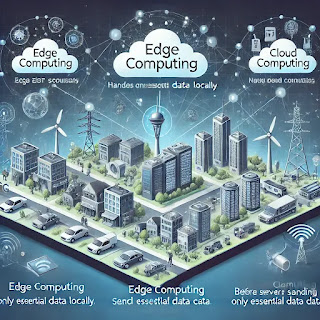Edge Computing: Bringing Processing Power Closer to the Data Source.
Imagine a self-driving car that
needs to make split-second decisions to avoid an accident. If it had to send
data to a faraway cloud server for processing, the delay—even just a few
milliseconds—could be catastrophic. This is where edge computing comes in. By
processing data closer to where it’s generated—whether in a car, a factory, or
a smartphone—edge computing reduces latency, enhances speed, and improves
efficiency.
But what exactly is edge
computing, how does it work, and why is it becoming so crucial in today’s
tech-driven world? Let’s break it down.
What Is Edge Computing?
Edge computing is a distributed
computing model where data processing happens near the source of data
generation—the "edge" of the network—rather than in a centralized
cloud or data center. Instead of sending every bit of information to distant
servers, edge devices (like sensors, smartphones, or IoT gadgets) handle
computations locally or through nearby edge servers.
How It Differs from Cloud Computing?
·
Cloud
Computing: Data travels to remote servers for processing (e.g., uploading a
video to YouTube).
·
Edge
Computing: Data is processed locally or nearby (e.g., facial recognition on
your phone without internet).
This shift reduces latency
(delay), bandwidth usage, and reliance on constant internet connectivity.
Why Edge Computing Matters Now?
Several trends are driving the adoption of edge computing:
1. Explosion of IoT Devices
·
By 2025, there will be over 75 billion IoT
devices worldwide (Statista).
·
Smart homes, wearables, and industrial sensors
generate massive data—sending it all to the cloud is inefficient.
2. Demand for Real-Time Processing
·
Applications like autonomous vehicles, AR/VR,
and telemedicine need instant decisions.
·
A delay of even 100 milliseconds can disrupt
surgeries or cause accidents.
3. Bandwidth and Cost Savings
·
Processing data locally reduces the strain on
networks.
·
Companies like Tesla use edge AI to process
camera data in real time rather than relying solely on cloud servers.
4. Enhanced Privacy & Security
·
Sensitive data (e.g., medical records) can be
processed locally, minimizing exposure to breaches.
How Edge Computing Works: Key Components.
Edge computing isn’t just one
technology—it’s an ecosystem. Here’s how it functions:
1. Edge Devices
These are the data generators: Smartphones,
sensors, cameras, drones, industrial machines.
Example: A smart
thermostat analyzing room temperature locally instead of sending constant
updates to the cloud.
2. Edge
Servers/Gateways
Small-scale data centers located
closer to devices:
·
A 5G tower with built-in servers to process
nearby traffic data.
·
A factory’s on-site server analyzing machine
performance in real time.
3. Fog Computing (The
Middle Ground)
A layer between edge and cloud
that aggregates data from multiple edge devices before sending relevant
insights to the cloud.
Real-World Applications
1. Autonomous
Vehicles
Tesla’s self-driving cars use
edge computing to process terabytes of sensor data per day in real time.
If a pedestrian steps onto the
road, the car reacts instantly—no waiting for cloud feedback.
2. Smart Cities
Traffic lights with edge AI
adjust signals based on real-time congestion.
Barcelona uses edge sensors to
optimize street lighting and waste management, saving millions in energy costs.
3. Healthcare
Wearable ECG monitors analyze
heart rhythms locally and only alert doctors if abnormalities are detected.
Reduces false alarms and speeds
up emergency responses.
4. Retail &
Customer Experience
Amazon Go stores use edge
computing to track purchases without cashiers.
Cameras and sensors process
transactions locally for instant checkouts.
Challenges & Limitations
While edge computing is powerful, it’s not without hurdles:
·
Hardware Limitations
·
Edge devices need enough processing power
without overheating or draining battery life.
·
Security Risks
·
More entry points for hackers—each edge device
is a potential vulnerability.
·
Management Complexity
·
Maintaining thousands of distributed devices is
harder than managing a centralized cloud.
·
Standardization Issues
·
Lack of universal protocols can lead to compatibility
problems between vendors.
The Future of Edge Computing
Experts predict that by 2028, the
edge computing market will exceed $61 billion (Grand View Research). Key
developments to watch:
·
5G + Edge
Synergy: Faster networks will enable even lower latency.
·
AI at the
Edge: More devices will run machine learning models locally (e.g., real-time
language translation).
·
Hybrid
Models: A balance between edge and cloud—critical data processed locally,
less urgent data sent to the cloud
Final Thoughts
Edge computing isn’t just a
buzzword—it’s a fundamental shift in how we handle data. By bringing processing
closer to the source, we enable faster, smarter, and more efficient systems.
Whether it’s a self-driving car avoiding collisions or a factory predicting
equipment failures before they happen, edge computing is reshaping industries.
As more devices become
interconnected, the need for real-time processing will only grow. Companies
that embrace edge computing today will be the leaders of tomorrow’s
hyper-connected world.
So next time your smart speaker responds instantly or your fitness tracker gives real-time feedback, remember—it’s all thanks to the power of the edge.






